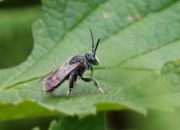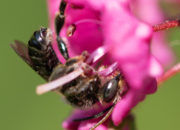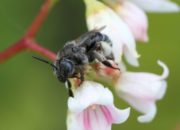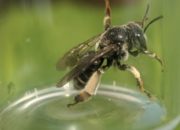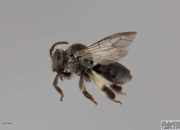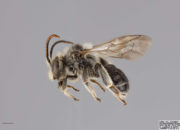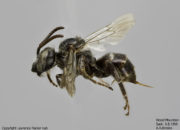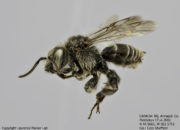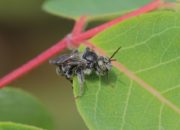Loosestrife Bees are among the rarest bees in the Northeast. They are unique in collecting oils from our native Loosestrifes (Genus Lysimachia) and are thus dependent on these yellow flowers. There is some evidence that these bees were once more common and widespread than they are today.
As the name implies, Loosestrife Bees are not going to be found far from Loosestrife flowers, which are yellow-flowered forbs common around wetlands and in shrubby areas. Not all the Lysimachia species in Vermont are useful for these bees. So far most of the recent VT records have been associated with Fringed Loosestrife (L. ciliata), though Whorled Loosestrife (L. quadrifolia) and Swamp Candles (L. terrestris) are also used. It is unclear if the non-native Lysimachia species are of any value to these bees – the often maligned Purple Loosestrife (Lythrum salicaria) is in a different family and ignored by Loosestrife Bees. Males occasionally visit other flowers in the area, particularly Spreading Dogbane (Apocynum androsaemifolium).
Look for Fringed Loosestrife and Spreading Dogbane in wet areas along meandering rivers, which may provide the nesting substrate for these ground nesting bees.
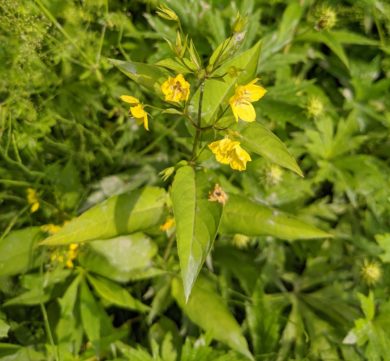
Fringed Loosestrife (L. ciliata) © Spencer Hardy
There is another, even rarer bee, that is an obligate kleptoparasite of Loosestrife bees and is so rare it was once thought to be globally extinct. It has since been re-found in several New England states. See Macropis Cuckoo Bee below.
Genus level ID: These bees are unlikely to be found away from blooming loosestrifes (June – August), however, most bees encountered on loosestrifes will not be Macropis. Look for a larger bee (slightly smaller than a honey bee) that is moderately hairy. Females look like they are wearing bell-bottoms, while males have yellow marks on their face.
Unless otherwise specified, photos are courtesy of Margarita Miklasevskaja at PCYU with funding from NSERC-CANPOLIN.
Species Accounts
**The links for the two VT species are drafts of the new species account format we will be rolling out in the second half of 2022**
A good key to the three New England species can be found here. Some, but probably not all, will be identifiable from photos. The hard part is finding the bees – take lots of photos if find one!
Dark-legged Yellow Loosestrife Bee (Macropis nuda) – Documented in the state prior to 1960, and subsequently found in 2020 and 2021. Perhaps the most common species in the state.
Patellate Yellow Loosestrife Bee (Macropis patellata) – Documented in the state prior to 1960, found at one site in both 2019 and 2020. Likely the rarest of the three species in the Northern US.
Macropis ciliata – Not yet found in the state, though the most common Macropis in Massachusetts.
Bonus bee
Macropis Cuckoo Bee (Epeoloides pilosula) – Listed as “Critically Imperiled” by Nature Serve. There are no known VT records, though it likely occurred here historically, and may still. Has been found several times recently in Massachusetts on Dogbane (Apocynum) in close association with Macropis and Loosestrife. A small, oddly proportioned, dark bee.
This map is displaying both Macropis records and records for the three species of Loosestrife (Genus Lysimachia) that the bees are likely to visit. Clearly the host plant is much more common than the bee!
